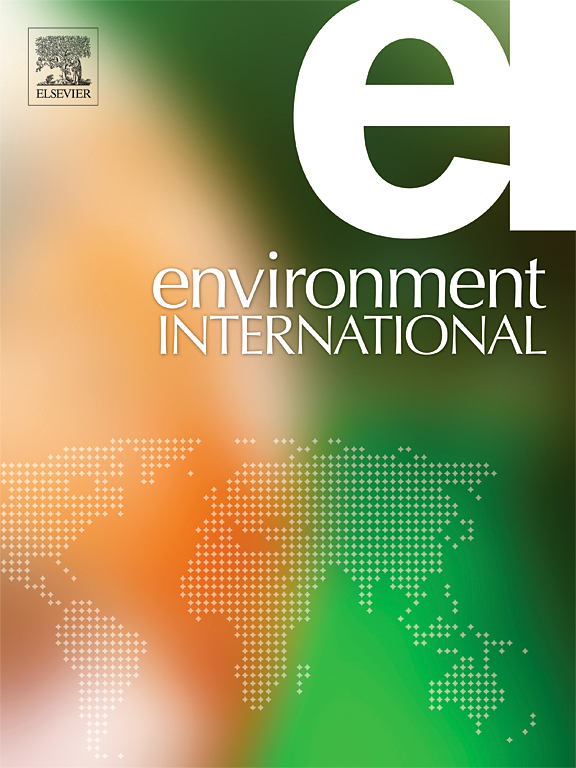Volatile organic compounds from typical industries in North China Plain: emissions, air pollution contribution, health risks, and policy implications
IF 10.3
1区 环境科学与生态学
Q1 ENVIRONMENTAL SCIENCES
引用次数: 0
Abstract
Volatile Organic Compounds (VOCs) are key precursors of ozone (O3) and secondary organic aerosols (SOA), which significantly impact air quality, human health, and climate. As China enhances VOCs emissions control, industry-specific strategies integrating emission characteristics, air pollution contribution, health risks and warming potential are urgently needed. This study measured VOCs emissions in 28 typical enterprises across 13 industries in an industrial city in Noth China Plain (NCP) through in-situ sampling to investigate the comprehensive impact of VOCs from industries. The entropy weight method is further utilized to investigate the integrated impacts and identify priorities of VOCs from industrial sectors. Results indicate that: (1) Current emission factors of industrial VOCs diverged substantially, with petrochemical (15.93 kg/t) and pharmaceutical (135 kg/t) industries being the most obvious emission sectors. (2) Chemical composition of VOCs varied across different industries, with surface coating emitting 69 % halogenated hydrocarbons, petrochemicals releasing 58 % aromatics, and pharmaceuticals discharging 53 % oxygenated VOCs (OVOCs). (3) Ozone formation potential peaked in surface coating (351.9 mg/m3, aromatics-driven) and olefin-rich organic chemical processes, while secondary organic aerosol potential was dominated by petrochemical aromatics (5,750 μg/m3). (4) Health risks are high in resin and plastic, pharmaceutical, and petroleum industries, with acrolein (HQ = 0.96) and acetaldehyde (cancer risk = 3.9 × 10-7) as priority hazards. (5) Based on detected greenhouse-effect VOCs, Freon-12/11 emissions dominated climate impacts (83 %, 467.1 tCO2-eq) in the petrochemical industry. (6) Entropy-weighted analysis prioritized petroleum for Tier-1 controls. Our results highlight the necessity of industry-specific emission factor revisions, reactivity-oriented controls, and multi-pollutant synergies in policy frameworks to address air quality, health, and climate challenges in the future.

华北平原典型工业挥发性有机化合物排放、大气污染贡献、健康风险及政策启示
挥发性有机化合物(VOCs)是臭氧(O3)和二次有机气溶胶(SOA)的主要前体,对空气质量、人类健康和气候产生重大影响。随着中国VOCs排放控制的不断加强,迫切需要针对特定行业制定综合排放特征、大气污染贡献、健康风险和变暖潜力的战略。本研究通过现场采样,对华北平原某工业城市13个行业28家典型企业的挥发性有机化合物(VOCs)排放量进行了测量,探讨了行业VOCs的综合影响。利用熵权法对各工业部门VOCs的综合影响进行了研究,并确定了VOCs的优先级。结果表明:(1)当前工业VOCs排放因子差异较大,其中石化(15.93 kg/t)和制药(135 kg/t)是排放最明显的行业;(2)不同行业VOCs的化学成分存在差异,表面涂层的卤化烃排放量为69% %,石化产品的芳烃排放量为58% %,药品的含氧VOCs排放量为53% %。(3)臭氧形成势在表面涂层过程(351.9 mg/m3,芳烃驱动)和富烯烃有机化学过程中达到峰值,二次有机气溶胶势以石化芳烃过程(5,750 μg/m3)为主。(4)树脂和塑料、制药和石油行业的健康风险较高,丙烯醛(HQ = 0.96)和乙醛(致癌风险 = 3.9 × 10-7)为优先危害。(5)基于检测到的温室效应VOCs,石化行业氟里昂-12/11排放主导气候影响(83 %,467.1 tCO2-eq)。(6)熵加权分析优先考虑了一级控制的石油。我们的研究结果强调了在未来应对空气质量、健康和气候挑战的政策框架中,有必要对特定行业的排放因子进行修订、以反应性为导向的控制和多污染物协同作用。
本文章由计算机程序翻译,如有差异,请以英文原文为准。
求助全文
约1分钟内获得全文
求助全文
来源期刊

Environment International
环境科学-环境科学
CiteScore
21.90
自引率
3.40%
发文量
734
审稿时长
2.8 months
期刊介绍:
Environmental Health publishes manuscripts focusing on critical aspects of environmental and occupational medicine, including studies in toxicology and epidemiology, to illuminate the human health implications of exposure to environmental hazards. The journal adopts an open-access model and practices open peer review.
It caters to scientists and practitioners across all environmental science domains, directly or indirectly impacting human health and well-being. With a commitment to enhancing the prevention of environmentally-related health risks, Environmental Health serves as a public health journal for the community and scientists engaged in matters of public health significance concerning the environment.
 求助内容:
求助内容: 应助结果提醒方式:
应助结果提醒方式:


